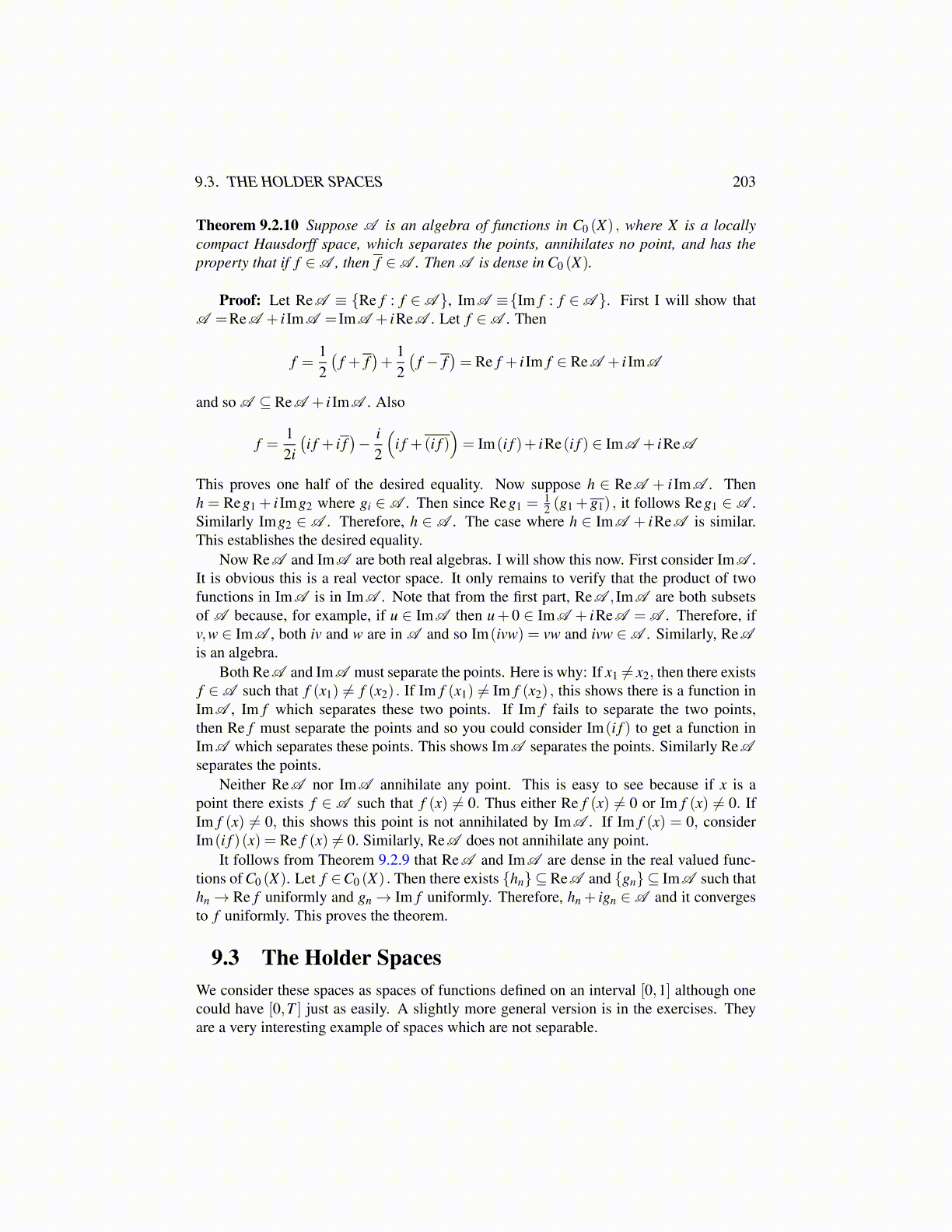
9.3. THE HOLDER SPACES 203
Theorem 9.2.10 Suppose A is an algebra of functions in C0 (X) , where X is a locallycompact Hausdorff space, which separates the points, annihilates no point, and has theproperty that if f ∈A , then f ∈A . Then A is dense in C0 (X).
Proof: Let ReA ≡ {Re f : f ∈A }, ImA ≡{Im f : f ∈A }. First I will show thatA =ReA + i ImA = ImA + iReA . Let f ∈A . Then
f =12(
f + f)+
12(
f − f)= Re f + i Im f ∈ ReA + i ImA
and so A ⊆ ReA + i ImA . Also
f =12i
(i f + i f
)− i
2
(i f +(i f )
)= Im(i f )+ iRe(i f ) ∈ ImA + iReA
This proves one half of the desired equality. Now suppose h ∈ ReA + i ImA . Thenh = Reg1 + i Img2 where gi ∈ A . Then since Reg1 =
12 (g1 +g1) , it follows Reg1 ∈ A .
Similarly Img2 ∈ A . Therefore, h ∈ A . The case where h ∈ ImA + iReA is similar.This establishes the desired equality.
Now ReA and ImA are both real algebras. I will show this now. First consider ImA .It is obvious this is a real vector space. It only remains to verify that the product of twofunctions in ImA is in ImA . Note that from the first part, ReA , ImA are both subsetsof A because, for example, if u ∈ ImA then u+ 0 ∈ ImA + iReA = A . Therefore, ifv,w ∈ ImA , both iv and w are in A and so Im(ivw) = vw and ivw ∈A . Similarly, ReAis an algebra.
Both ReA and ImA must separate the points. Here is why: If x1 ̸= x2, then there existsf ∈A such that f (x1) ̸= f (x2) . If Im f (x1) ̸= Im f (x2) , this shows there is a function inImA , Im f which separates these two points. If Im f fails to separate the two points,then Re f must separate the points and so you could consider Im(i f ) to get a function inImA which separates these points. This shows ImA separates the points. Similarly ReAseparates the points.
Neither ReA nor ImA annihilate any point. This is easy to see because if x is apoint there exists f ∈ A such that f (x) ̸= 0. Thus either Re f (x) ̸= 0 or Im f (x) ̸= 0. IfIm f (x) ̸= 0, this shows this point is not annihilated by ImA . If Im f (x) = 0, considerIm(i f )(x) = Re f (x) ̸= 0. Similarly, ReA does not annihilate any point.
It follows from Theorem 9.2.9 that ReA and ImA are dense in the real valued func-tions of C0 (X). Let f ∈C0 (X) . Then there exists {hn} ⊆ReA and {gn} ⊆ ImA such thathn→ Re f uniformly and gn→ Im f uniformly. Therefore, hn + ign ∈A and it convergesto f uniformly. This proves the theorem.
9.3 The Holder SpacesWe consider these spaces as spaces of functions defined on an interval [0,1] although onecould have [0,T ] just as easily. A slightly more general version is in the exercises. Theyare a very interesting example of spaces which are not separable.